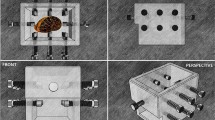Abstract
Coral has ben used for the last ten years as bone substitution in the body because of its mechanical an osteoconductor properties. Our primary studies have shown, for the first time, the quantitative behavior of the atomic components. We study by some physical method of analysis a biocoral implanted “in vivo”. The natural biocorals used in this work are the calcium carbonated exoskeletons built by Madrepian coral polyps. Neutron activation analysis showed that initial coral, essentially CaCO3, becomes a new material which has a mineral composition close to that of bone. In this work, we have studied the calcification mechanism of this implant by using radioactive tracers. We have established the transfer kinetics of calcium biomaterial in the blood circuit and showed its use by the organism for skeleton mineralization.
Similar content being viewed by others
References
T. SAUVAGGE, Etude par des méthodes nucléaires d'analyse des transformations physico-chimiques du corail implanté “in vivo”. Thèse n0 DU 406/PCCF T 9201, Université Blaise-Pascal, 1992, France.
H. OUDADESSE, Etude des phénomènes physiques dans la transformation du corail implanté “in vivo” par radioactivation nucléaire, par diffraction des rayons X et par spectrométrie infrarouge. Thèse n0 DU 158/PCCF T 8901, Université Blaise-Pascal, 1989, France.
Socěté Industrielle INOTEB Du corail à biocorail. 18, rue André del Sarte, 75018 Paris.
N. D. ANDERSON, Jons Hopkins, Med. J., 145 (1979) 73.
H. EL FADL, Determination d'éléments atomiques sous forme de traces dans un biomatériau par radioactivation neutronique et analyse de la température de transition de phase aragonite-calcite. Thèse n0 DU 282/PCCF T 9006, Université Blaise-Pascal, 1990, France.
G. GUILLEMIN, J. FOURNIE, J. L. PATA, M. CHETAIL, C.R. Acad. Sci. Paris, 293 (1981) 371.
J. L. IRIGARAY, H. OUDADESSE, G. BLONDIAUX, D. COLLANGETTES, Structure study of coral implanted “in vivo” by nuclear activation analysis and by X-ray diffraction, Nuclear Analytical Methods in the Life Sciences, International Congress of Gaithersburg, Maryland, U.S.A., 17–21 April, 1989.
P. BESANCON, Les principales voies du métabolisme calcique chez le porc et le lapin en croissance. Etude de l'influence du niveau calcique, Thèse, Paris, 1971.
Author information
Authors and Affiliations
Rights and permissions
About this article
Cite this article
Irigaray, J.L., Sauvage, T., Oudadesse, H. et al. Study of the mineralization of coral implanted in vivo by radioactive tracers. Journal of Radioanalytical and Nuclear Chemistry, Articles 174, 93–102 (1993). https://doi.org/10.1007/BF02040337
Received:
Issue Date:
DOI: https://doi.org/10.1007/BF02040337




